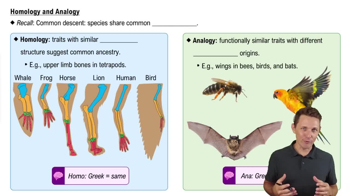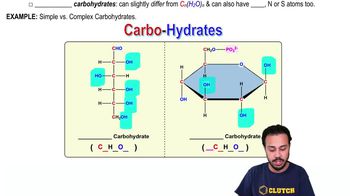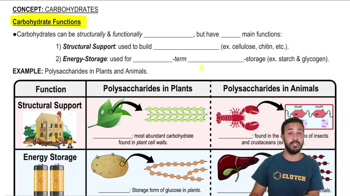Table of contents
- 1. Introduction to Biology2h 42m
- 2. Chemistry3h 40m
- 3. Water1h 26m
- 4. Biomolecules2h 23m
- 5. Cell Components2h 26m
- 6. The Membrane2h 31m
- 7. Energy and Metabolism2h 0m
- 8. Respiration2h 40m
- 9. Photosynthesis2h 49m
- 10. Cell Signaling59m
- 11. Cell Division2h 47m
- 12. Meiosis2h 0m
- 13. Mendelian Genetics4h 44m
- Introduction to Mendel's Experiments7m
- Genotype vs. Phenotype17m
- Punnett Squares13m
- Mendel's Experiments26m
- Mendel's Laws18m
- Monohybrid Crosses19m
- Test Crosses14m
- Dihybrid Crosses20m
- Punnett Square Probability26m
- Incomplete Dominance vs. Codominance20m
- Epistasis7m
- Non-Mendelian Genetics12m
- Pedigrees6m
- Autosomal Inheritance21m
- Sex-Linked Inheritance43m
- X-Inactivation9m
- 14. DNA Synthesis2h 27m
- 15. Gene Expression3h 20m
- 16. Regulation of Expression3h 31m
- Introduction to Regulation of Gene Expression13m
- Prokaryotic Gene Regulation via Operons27m
- The Lac Operon21m
- Glucose's Impact on Lac Operon25m
- The Trp Operon20m
- Review of the Lac Operon & Trp Operon11m
- Introduction to Eukaryotic Gene Regulation9m
- Eukaryotic Chromatin Modifications16m
- Eukaryotic Transcriptional Control22m
- Eukaryotic Post-Transcriptional Regulation28m
- Eukaryotic Post-Translational Regulation13m
- 17. Viruses37m
- 18. Biotechnology2h 58m
- 19. Genomics17m
- 20. Development1h 5m
- 21. Evolution3h 1m
- 22. Evolution of Populations3h 52m
- 23. Speciation1h 37m
- 24. History of Life on Earth2h 6m
- 25. Phylogeny2h 31m
- 26. Prokaryotes4h 59m
- 27. Protists1h 12m
- 28. Plants1h 22m
- 29. Fungi36m
- 30. Overview of Animals34m
- 31. Invertebrates1h 2m
- 32. Vertebrates50m
- 33. Plant Anatomy1h 3m
- 34. Vascular Plant Transport1h 2m
- 35. Soil37m
- 36. Plant Reproduction47m
- 37. Plant Sensation and Response1h 9m
- 38. Animal Form and Function1h 19m
- 39. Digestive System1h 10m
- 40. Circulatory System1h 57m
- 41. Immune System1h 12m
- 42. Osmoregulation and Excretion50m
- 43. Endocrine System1h 4m
- 44. Animal Reproduction1h 2m
- 45. Nervous System1h 55m
- 46. Sensory Systems46m
- 47. Muscle Systems23m
- 48. Ecology3h 11m
- Introduction to Ecology20m
- Biogeography14m
- Earth's Climate Patterns50m
- Introduction to Terrestrial Biomes10m
- Terrestrial Biomes: Near Equator13m
- Terrestrial Biomes: Temperate Regions10m
- Terrestrial Biomes: Northern Regions15m
- Introduction to Aquatic Biomes27m
- Freshwater Aquatic Biomes14m
- Marine Aquatic Biomes13m
- 49. Animal Behavior28m
- 50. Population Ecology3h 41m
- Introduction to Population Ecology28m
- Population Sampling Methods23m
- Life History12m
- Population Demography17m
- Factors Limiting Population Growth14m
- Introduction to Population Growth Models22m
- Linear Population Growth6m
- Exponential Population Growth29m
- Logistic Population Growth32m
- r/K Selection10m
- The Human Population22m
- 51. Community Ecology2h 46m
- Introduction to Community Ecology2m
- Introduction to Community Interactions9m
- Community Interactions: Competition (-/-)38m
- Community Interactions: Exploitation (+/-)23m
- Community Interactions: Mutualism (+/+) & Commensalism (+/0)9m
- Community Structure35m
- Community Dynamics26m
- Geographic Impact on Communities21m
- 52. Ecosystems2h 36m
- 53. Conservation Biology24m
4. Biomolecules
Carbohydrates
Problem 2`
Textbook Question
A glucose molecule is to starch as (Explain your answer.) a. a steroid is to a lipid. b. a protein is to an amino acid. c. a nucleic acid is to a polypeptide. d. a nucleotide is to a nucleic acid.
 Verified step by step guidance
Verified step by step guidance1
Step 1: Begin by understanding the relationship between glucose and starch. Glucose is a monosaccharide (simple sugar), while starch is a polysaccharide (complex carbohydrate) made up of many glucose molecules linked together. This relationship is one of a building block (glucose) forming a larger structure (starch).
Step 2: Analyze each answer choice to determine if it represents a similar 'building block to larger structure' relationship. For example, in option (a), a steroid is not a building block of lipids; rather, it is a type of lipid. This does not match the glucose-to-starch relationship.
Step 3: Evaluate option (b). Proteins are made up of amino acids, which are their building blocks. This is the reverse of the glucose-to-starch relationship, as amino acids are smaller units forming a larger structure (protein).
Step 4: Consider option (c). Nucleic acids are composed of nucleotides, not polypeptides. Polypeptides are chains of amino acids that form proteins, so this option does not match the glucose-to-starch relationship.
Step 5: Examine option (d). Nucleotides are the building blocks of nucleic acids, just as glucose is the building block of starch. This matches the relationship described in the problem, where smaller units combine to form a larger structure.
 Verified video answer for a similar problem:
Verified video answer for a similar problem:This video solution was recommended by our tutors as helpful for the problem above
Video duration:
1mPlay a video:
Was this helpful?
Key Concepts
Here are the essential concepts you must grasp in order to answer the question correctly.
Monomers and Polymers
Monomers are the basic building blocks of larger molecules known as polymers. In the context of carbohydrates, glucose is a monosaccharide (a simple sugar) that serves as a monomer, while starch is a polysaccharide (a complex carbohydrate) made up of many glucose units linked together. Understanding this relationship is crucial for analyzing how smaller units combine to form larger structures.
Recommended video:
Guided course

Monomers & Polymers
Biomolecules
Biomolecules are organic molecules that are essential for life, including carbohydrates, proteins, lipids, and nucleic acids. Each type of biomolecule has specific functions and structures. Recognizing the categories of biomolecules helps in understanding their roles in biological systems, such as how glucose (a carbohydrate) relates to starch (a carbohydrate polymer).
Recommended video:
Guided course

Introduction to Biomolecules
Analogous Relationships
Analogous relationships in biology refer to the comparison between two sets of items that share a similar function or structure but are different in composition. In this question, the relationship between glucose and starch is analogous to the relationships presented in the answer choices, where a smaller unit (monomer) relates to a larger unit (polymer) in each case. Identifying these analogies is key to selecting the correct answer.
Recommended video:

Homology and Analogy
Related Videos
Related Practice
















